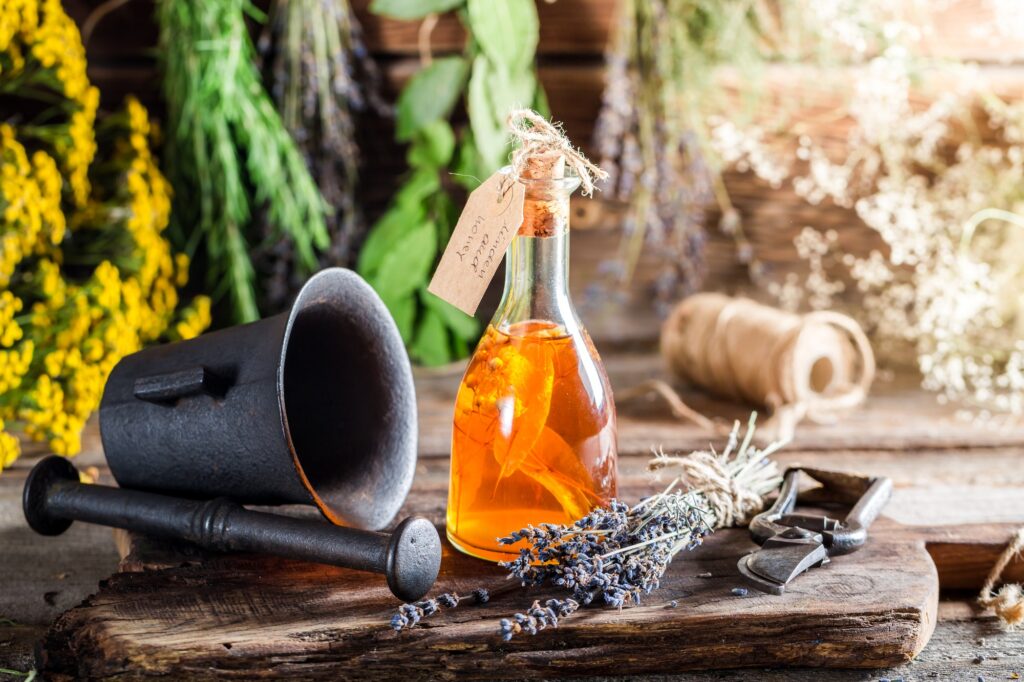
5 Menopause Support Complex Supplement to Help Ease Symptoms
Menopause support complexes are dietary supplements with herbal extracts and vitamins aimed at alleviating symptoms during menopause
When it comes to human history, few ingredients can match the mystique and impact of turmeric. Used in various forms ranging from food and beverage to holistic medicines and skincare, this vibrant yellow-hued spice is known for its flavor as much as its purported healing and restorative power. With its ancient history and use in a multitude of cultures across the world, it’s no wonder why many are quick to point to turmeric as an ingredient that’s had a place in history for centuries.
At the same time, is this story too good to be true? From ancient India to modern Germany, many of the uses of turmeric throughout recorded history have often been shrouded in mystery. Today, however, we’re closer than ever to uncovering the secrets of this dreamy spice. By reliving its journey from the past to present-day, we’ll unearth just how ingrained this ingredient has been to cultures around the world for generations. And, of course, the numerous health and wellness benefits are important to many these days!
So, if you’re looking for an activity to transcend the ordinary, join me on this journey into the past as we explore the mysterious and inspiring role of turmeric in human history. Let’s get started!
Turmeric is a spice well known for both its medicinal and culinary uses. But what is turmeric and where does it come from? Native to Southeast Asia, turmeric (also known as Curcuma longa) is an herbaceous perennial plant in the ginger family.1 The main part of turmeric that is used as a spice is the root or rhizome of the plant, which was traditionally dried and ground into a powder before being used. This yellow-orange powder has been popularly used in many Asian cuisines for thousands of years, most notably Indian cuisine. Alongside its culinary uses, turmeric has a long history of use in traditional medicine due to its active ingredient curcumin and is said to possess antioxidant, anti-inflammatory, and even anticancer properties.2
Modern day cultivation of turmeric mostly occurs in India, although Thailand and China also play major roles in its production and export.3 With increasing awareness about its medicinal benefits throughout society, turmeric has seen a resurgence in popularity worldwide.4 This brings up an important question – Is it better to source locally grown turmeric or support growers in large exporters like India? On one hand, buying local will reduce carbon footprint and could potentially drive local economic growth but on the other hand, visiting smaller farms may expose farmers to unfair labor practices. Overall both have their advantages and debate on which is ‘more ethical’ can be endless however one thing is for sure – sourcing organic if possible will improve the welfare of the land where it grows as well as those that grow it.

Throughout ancient times, turmeric has been used for various reasons within different cultures. It has a long-standing history in Hinduism, where it is associated with prosperity and fertility; the marriage ceremony often involves its use as an offering. One of the most traditional uses of turmeric is medicinal—it has a reputation for promoting overall health and well being. In India, ayurvedic medicine has traditionally used turmeric to treat digestive problems like acidity, as well as skin ailments like psoriasis and inflammation.
The debate arises when looking at potential safety concerns related to turmeric consumption. While some argue that traditional medicinal uses give turmeric a long history of safety, others note that further research must be done on any potential side effects. Turmeric supplements have not been studied extensively in the United States, so much of the evidence is drawn from research conducted in other countries—which may not directly apply to U.S. populations. As such, real clinical trials are needed to determine if turmeric may act as either a medical remedy or aggravate existing conditions.
In conclusion, turmeric holds a deep cultural and medicinal history across many ancient societies. With this in mind, it’s important for us to continue to understand how modern socio-cultural practices link back to learning more about turmeric-based remedies used by our ancestors in multiple societies. Next up we will explore how these traditional uses have evolved into modern forms found in Indian Ayurvedic medicine today.
Turmeric has been used for centuries in India by healers as an herbal medicine under the traditional system of Ayurvedic medicine. Ayurvedic medicine is an ancient medicine science that dates back over 5,000 years. It originated in India, and it is still practiced now by many people around the world. The goal of Ayurvedic medicine is to promote health, prevent illness, and treat disease using herbs, diet and lifestyle therapies. Turmeric has been used to treat various conditions ranging from digestive problems to arthritis in Ayurveda because of its immense healing properties.
Proponents of this practice claim that turmeric provides antioxidants and has anti-inflammatory benefits which help reduce inflammation and swelling in the body. Additionally, they believe that it can be used to reduce fevers, improve digestion, and treat skin diseases. While opponents may argue about the lack of scientific evidence for these claims, many studies have revealed that turmeric has anti-cancer properties.
Turmeric has a long history as an effective agent in Ayurvedic medicine to prevent and treat illnesses such as liver damage and respiratory diseases. Although further research is needed to understand how turmeric works in the human body at a cellular level, the potential is still great for its medicinal use due to its antioxidant and anti-inflammatory effects on chronic disorders like arthritis or cancer. With all its potential medicinal benefits, it’s no surprise that turmeric holds a special place within Indian culture and also within English-speaking cultures around the world who are embracing Ayurvedic practices.

Turmeric has been used for centuries in India to treat various ailments like digestive problems and arthritis, due to its anti-inflammatory and antioxidant benefits. Although opponents of its medicinal use may point out the lack of scientific evidence, studies have revealed that turmeric may have anti-cancer properties. Turmeric has also been used in Ancient Chinese Medicine as part of their medicinal regimens.
The widespread use of turmeric across different cultures and backgrounds can be seen in many forms and extends back into ancient times. One example is the use of turmeric in Ancient Chinese medicine, a practice believed to have evolved over 5,000 years ago. Historically, Ancient Chinese medicine was rooted in a holistic approach to healthcare and believed that all diseases were caused by imbalances in Qi which can only be restored by an individual’s harmonious relationship with their environment.
While some ancient practices are still used today, Chinese medicine has been improved by scientific evidence. Turmeric is believed to be one of the oldest healing herbs used in Traditional Chinese Medicine (TCM), and alongside other herbs, to be used as part of individualized treatment plans. In TCM, turmeric is thought to regulate Qi throughout the body, purify the blood, alleviate pain, reduce inflammation and treat skin conditions such as eczema and psoriasis. Some believe that it can also help boost circulation and digestion while helping address ailments such as colds and flu.
Despite its potential therapeutic benefits, some experts criticize TCM for lack of evidence-based research results. Furthermore, some believe that treating medical conditions with herbs such as turmeric may have negative side effects if not monitored correctly or at prescribed doses.
Turmeric is very commonly used in various culinary delights, both current and historic. Turmeric has been used to add flavor and color to both savory dishes and sweet desserts, giving many traditional recipes a recognizable yellow or orange hue. Additionally, turmeric is one of the components of curry spice blends commonly used in Indian cuisine, combining with other spices like cumin, coriander and cardamom to create a uniquely flavorful mix.
Though turmeric has been a popular component in many traditional dishes for centuries, some experts argue that it may not be the ideal addition to modern nutritional diets. They caution that having too much turmeric can cause potential stomach upset for people with sensitive digestive systems, due to its high level of curcumin. Those who have had gallbladder surgery are warned against overconsumption of turmeric due to its lack of efficacy in breaking down fat molecules.
On the other hand, supporters of incorporating turmeric into meals argue that it has vast antioxidant qualities along with anti-inflammatory benefits. In addition, studies have indicated that turmeric’s medicinal properties have a wide range of health benefits from lowering cholesterol levels to reducing risk of cancer and seizures.
Regardless of the debate surrounding its inclusion in meals, it is clear that turmeric has been an important part of many cultural cuisines throughout human history. Moving on now towards exploring further uses of this ancient herb beyond culinary applications–the next section will focus on spices and herbs.

Spices and herbs have long been used in various cultures to enhance flavors, preserve food and create medicinal remedies. Throughout history, spices and herbs have been prized for their healing properties, valuable aroma and their ability to add interest to dishes.
The use of herbs and spices can be traced back thousands of years. Ancient Egyptians used them for religious and medical purposes, while ancient Greek physicians utilized spices such as cinnamon to treat gout. Likewise, the Chinese have traditionally looked to ginger for its potential health benefits. In India, turmeric was revered for its medicinal properties; Hindus often used it as a dye for clothing, offering plates to the gods and sprinkling it on brides and bridegrooms before marriage ceremonies.
Some argue that too much of certain herbs or spices could be detrimental to health, such as those rich in sodium or saturated fats since they can lead to hypertension or high blood pressure levels. Conversely, other studies imply that too little consumption of dietary condiments may lead to an increased risk of cardiovascular disease due to an inadequate intake of essential nutrients essential for optimal vascular functioning. Nevertheless, many herbs and spices are a source of antioxidants which can help reduce oxidative stress-induced inflammation in the body.
With all these different uses in mind, it is no surprise that turmeric has historically been held in high regard – especially related to health benefits. In the next section we will further explore the potential health benefits of this ancient spice.
Turmeric, also known as Curcuma longa, is a spice native to India and Southeast Asia, known for its bright yellow-orange color and distinct flavor. This fragrant root has been consumed for hundreds of years for medicinal purposes and employed in traditional cuisine. As modern scientific research advances the understanding of natural healing, the potential health benefits of turmeric are now becoming more widely acknowledged in the health community.
Scientific evidence suggests that turmeric may help to reduce inflammation, improve cognitive function and digestive health, treat anxiety and depression, and even protect against chronic diseases such as cancer and diabetes. With anti-inflammatory properties like curcumin, which is found in turmeric, many studies have shown that regular consumption of turmeric can reduce inflammation markers in the body like hs-CRP (high sensitivity C-reactive protein) and TNF-α(Tumor necrosis factor). Furthermore, it may slow the oxidation process that can lead to cancer cell growth.
On the other hand, the actual efficacy of turmeric’s health benefits still require more clinical trials to fully understand the positive impact that this spice may have on human availability. In addition, not all practitioners agree on how much turmeric should be taken on a daily basis or what form (powder or extract) is best suited to achieve desired outcomes. It’s important to remember that each person reacts differently to foods and supplements due to individual dietary needs and physiological make-up; therefore it is always best to speak with a qualified healthcare professional prior to taking action.
Turmeric has experienced an immense surge in popularity as an ingredient for modern-day nutrition and health. Proponents of the use of turmeric tout its antioxidant, anti-inflammatory, and antifungal properties, amongst numerous other benefits. It is most commonly used to make curries, teas, and supplements. The active ingredient in turmeric is “curcumin” which has numerous powerful biological effects. It contains a large amount of potential anti-cancer properties and can reduce inflammation by suppressing inflammatory molecules in the body. Evidence shows that there could be a strong link between consuming turmeric and improved cognitive performance as well as improved cardiovascular health due to reducing cholesterol levels. Although some research has suggested that there are many potential health benefits associated with using turmeric, unfortunately many of these claims are still yet to be studied properly or conclusively backed up by more concrete evidence.
Critics argue that consuming high amounts of curcumin could actually induce stomach problems such as nausea and diarrhea. Some studies have also suggested that curcumin may inhibit iron absorption in the body – leading to iron deficiency if consumed in excess – so should be eaten alongside foods that contain calcium or Vitamin C for these effects to be minimized. In addition, eating too much turmeric can lead to jaundice – further highlighting the need for moderation when it comes to consumption.
Given both the scientific evidence as well as anecdotes from traditional cultures suggesting potentially positive impacts on overall health combined with limited evidence pointing out any actual risks; modern individuals may find some benefit in including carefully moderated amounts of turmeric (in the form of curry dishes and teas) into their diets either as a supplement or as part of regular meals. In light of this discussion, we’ll now turn our focus towards our final thoughts on the history and cultural uses of turmeric.

Turmeric has been a part of world history for centuries and its diverse range of uses reveals the vast potential for a single plant. This article aimed to uncover the ancient history and cultural uses of turmeric, from its origins in the South Asian region to its place within East Asian cuisine, medicine, and spirituality.
Turmeric’s evolution from an ingredient used to combat foodborne illnesses in India centuries ago to an internationally renowned dietary supplement can be traced through religious, medical, culinary and cultural practices. Its antiseptic qualities made it an important spice during the Vedic period in India, as evidenced by its regular mention in the Rigveda and other Hindu scriptures. In traditional Chinese medicine, turmeric is viewed as a remedy for various ailments and diseases such as rheumatic and abdominal problems. In modern contexts, turmeric is now being studied for its therapeutic properties in combating inflammation-related disorders such as obesity, metabolic syndrome and cardiovascular disease.
The medicinal properties that have allowed turmeric to remain an important factor in many cultures over centuries also extend to its culinary uses. As the lineages of these recipes and techniques became identified with distinct regional cultures, so too did the use of turmeric become intertwined with a culture’s customs. For instance, Southeast Asian nations regularly use turmeric as a marinade or fish sauce base. Some Middle Eastern recipes incorporate turmeric in their desserts while others add it to stews, curries or rice dishes alongside other aromatics such as ginger, garlic or cardamom pods.
In addition to its culinary and medicinal contributions, studies suggest that turmeric holds special spiritual significance to Buddhists who believe that consuming it brings greater mindfulness into the practice of meditation. While not essential due to Buddhism rejecting legalistic precepts concerning dietary practices, those who do choose to consume it regard it positively within their spiritual framework as a symbol of knowledge, truth and purity; all concepts which are central tenets of Buddhist teachings.
The wide range of health benefits offered by turmeric is evidenced by numerous studies focused on its anti-inflammatory properties as well as certain neuroprotective effects in cases of stroke or depression. On one hand there is research pointing to the fact that curcumin – one of the main active ingredients found in turmeric – may benefit people suffering from arthritis or heart disease when taken in conjunction with conventional therapies; however there are also studies that suggest that higher quantities could indeed be harmful if taken without proper medical consultation first. Lastly, while many individuals report positive outcomes following curcumin supplementation this should also be evaluated on an individual basis as some have experienced allergic reactions or disturbances in overall blood sugar levels when taking too large a dosage.
In conclusion, this article has uncovered various aspects related to the ancient use of Turmeric including its historical importance in religious ceremonies throughout South Asia to its contemporary applications within modern day medicine and cuisine around the world. The various ways that cultures have employed this revered spice provide insight into how different civilizations have interacted with one another over time; creating unique recipes and fusions between countries resulting in delectable dishes peppered with healing properties enjoyed by many today. Keeping this mix of traditions alive we are able to marvel at how one single plant has transcended hundreds of years – taking us back full circle to rediscover something so meaningful by our ancestors yet still relevant today; a true testament then to what Turmeric means for our past and our future.

Over the centuries, turmeric has been an essential ingredient in many cultures around the world. Originally used in India as a spice to add flavor and a yellow-tinge to food, it is documented as one of the earliest crops to be cultivated in South Asia. Through the centuries, its medicinal purposes slowly began to be discovered, leading to the use of turmeric in Ayurvedic medicine.
Today, turmeric continues to have an important role in both culinary and remedial uses across many cultures. With the rise of holistic health and natural treatments, more medical practitioners are looking towards turmeric for its healing properties as anti-inflammatory and anti-bacterial agents, among others. In addition to its health benefits, turmeric is being used in everything from beauty treatments to fabric dyeing for its vibrant color.
Turmeric has a long history of being used to treat various ailments in traditional medicine. It is known for containing powerful antioxidant and anti-inflammatory properties, which can help reduce inflammation, improve digestive health, and aid in the fight against cancer.
It is also believed to help boost the immune system and rid the body of toxins by aiding in the digestion and absorption of nutrients. Additionally, it has been used to treat arthritis, eczema, colds and flu symptoms, as well as other skin issues.
Researchers have found that turmeric helps reduce cholesterol levels, which can help lower risk of heart disease. It can also protect against neurological diseases like Alzheimer’s and Parkinson’s due to its ability to slow down degeneration of neurons in the brain.
Some studies have even found that turmeric may help reduce symptoms of depression. Lastly, turmeric is thought to detoxify the liver and reduce blood sugar levels for those with type 2 diabetes.
Turmeric has a long and varied history of use in many cultures throughout the world. It is used extensively in South Asian cuisines, including Indian and Sri Lankan dishes. In India, turmeric has been used in ayurvedic medicine for centuries as an anti-inflammatory, digestive aid, and skin tonic. In Indonesia, Laos, Vietnam, and other Southeast Asian nations, turmeric is added to curry pastes and spice mixes. In Indonesia, turmeric is served at traditional ceremonies alongside various other offerings. Finally, in Africa turmeric is used to flavor foods such as grain porridge and sauces.
Overall, South Asia countries use turmeric most widely as part of their food and medicinal systems. However its usage extends across many countries and cultures around the world.

Menopause support complexes are dietary supplements with herbal extracts and vitamins aimed at alleviating symptoms during menopause

Vitamin C, D3, Zinc, and Quercetin support immune health. They enhance immune cell function, fight infections, reduce inflammation, and provide antioxidant benefits.

Ginseng, a valued herb with adaptogenic and antioxidant properties, is popular as a supplement for improved well-being, energy, and immune function.

Nootropic supplements enhance focus, memory, and cognitive function. They boost mental clarity, motivation, and creativity for improved performance and brain health.

Garcinia cambogia, a tropical fruit, is touted for weight loss. Its active ingredient, HCA, may inhibit fat formation, but evidence is limited. Consult a professional before use.

More and more people are jumping on the mushroom supplement bandwagon these days, but you should be aware that there are potential side effects you should know about before taking the plunge. Whether you’re begging for overall well being or looking for an extra performance boost, you’re going to want to make sure you’re making an informed decision before adding mushroom supplements to your daily routine. We’ve put together a list of potential side effects to look out for, so read on and learn the truth before you start popping those pills.

Moringa, the “miracle tree,” offers numerous benefits. Moringa supplements provide essential nutrients, antioxidants, anti-inflammatory effects, and potential blood sugar and cholesterol regulation. They support immunity and combat malnutrition, but medical advice is essential.

It’s a good thing that Mother Nature both created and found cures for many of the ailments we humans suffer from. From the common cold to serious diseases, herbs have the potential to not only alleviate symptoms, but to completely prevent illnesses in the first place! Herbal remedies for immune system support have become increasingly popular as natural ways to boost your immunity against illness start to catch on.
